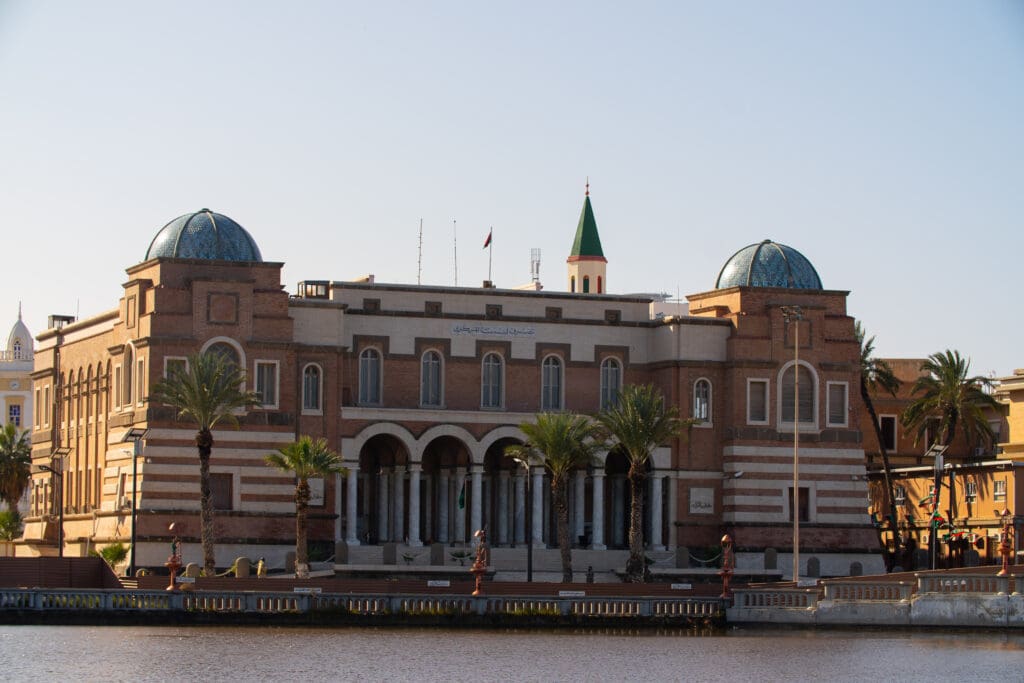Libya’s latest political standoff, this time over who should head the country’s central bank, has once again highlighted the chronic dysfunction that has plagued the country since the 2011 overthrow of Moammar Gaddafi. Libya’s political economy, militarized and bedeviled by foreign interference, is broken: unsuitable even for Libya’s rival leaders, incapable of constraining them, and perennially unable—by design—to meet the needs of ordinary Libyans.
The failure of the system becomes evident through its repeated breakdowns: closures of oil fields, military flare-ups, announcements that politicians no longer recognize one another. Often read as standalone events, these are in fact natural features of a system made up of a series of overlapping political agreements and quasi-constitutional documents built to manage Libya and divide control over its wealth.
Yet the international community stubbornly attempts to restart the same system every time it fails, desperate to avoid the cost of building something new like an impatient technician stabbing at a computer’s restart button, trying to squeeze a bit more use out of an obviously broken machine. This is why Libya’s failure is periodic, and its breaking points, each of which reveals a deeper problem, now familiar.
The latest stand-off began on August 5, when Saddam Haftar, the notoriously hot-headed son of eastern Libya’s dictator Khalifa Haftar, shut down Libya’s largest operational oil field. That move was intended to punish Europe, after Saddam, who is a senior commander in his father’s self-styled Libyan Arab Armed Forces (LAAF), was detained in Napoli as part of a Spanish investigation into weapons smuggling. The field he shut down is co-operated by an all-European line-up: France’s TotalEnergies, Austria’s OMV, Norway’s Equinor, and Spain’s Repsol.
This move demonstrated the younger Haftar’s determination to guard his longstanding impunity, especially given his reported ambitions to succeed his father. It also showcased a deepening trend among the Haftar family to use Libya’s resources and infrastructure as their personal property. This wasn’t the first time they had shut down Libyan oil exports for political goals, but they had never done so for something so petty. It was telling that Saddam tried to blame the closure on local protestors, showing he is mindful of optics, given the blockade would cause local power shortages and worsen pre-existing fuel shortages.
Shortly afterwards, Saddam — who, like his father, desires to take control of the capital Tripoli—sent a large force westwards in a likely bid to seize the last oil-producing territory in Libya still beyond his control, the Ghadames basin. He also hoped to take over key border crossings with Algeria and Tunisia, and ideally a chunk of territory west of the capital. The plan was to create an overnight fait accompli, utilizing a local ally who would secretly convince the region’s constellation of armed groups to join Haftar’s forces, allowing Saddam to simply move in a manner that would dissuade his rivals from attacking his new positions. It is a strategy used regularly by his father.
However, his proxy failed to flip enough local forces, and the grand march west, widely broadcast on social media, put forces aligned to the Tripoli government on high alert. Saddam then shifted his narrative, claiming the operation had always been a mission, coordinated with Algeria, to secure Libya’s borders following recent violence in Mali—notwithstanding the fact that Mali’s closest border lies around 1,000 kilometers (600 miles) from Libya, and that Algeria publicly denounced the LAAF’s movements.
Force as Legitimacy
As all this was playing out, the Haftar clan’s rivals, led by Tripoli-based interim Prime Minister Abdul Hamid Dbeibah, were also plotting. Over the course of the year, Dbeibah had been forced to cut his spending drastically following a feud with the governor of the Central Bank of Libya (CBL), Sadiq El-Kabir. This had played in favor of the Haftars, as El-Kabir sent funds their way instead. They were also earning oil revenues by cannibalizing Libya’s National Oil Company through a fuel-for-crude scheme. In response, Dbeibah started looking for ways to oust the CBL governor, leveraging his own control over Libya’s political institutions.
In a pre-emptive attempt to defang the Dbeibah plan, on August 13 Libya’s parliament—which is controlled by the Haftars and their loyalists—issued a legal ruling aimed at delegitimizing Dbeibah’s government and the accompanying three-seated Presidency Council, which is technically Libya’s head of state. The parliament argued that the mandates of both bodies had expired—with no hint of irony, from a legislature itself elected in 2014 which hasn’t made quorum in years.
Nevertheless, on August 19, the Presidency Council issued a decree sacking El-Kabir. Again, this was legally incoherent, given that the Presidency Council doesn’t really have that right, and that its decree was based on a 2018 law that has since been rescinded. However, when all state bodies’ mandates have expired and loopholes are all that remain of political agreements, force becomes the only source of legitimacy.
El-Kabir hunkered down in the bank, knowing that if he left, militias wouldn’t let him return. Dbeibah, meanwhile, twisted the screws and replaced the head of the national body purchasing the fuel that Haftar so lucratively smuggles.
But Dbeibah’s ill-executed gambit failed. While El-Kabir will probably still be replaced, this will now be an agonizing negotiation rather than a fait accompli. The political heads and military muscles of Libya’s broken system are setting up a new board for the CBL, echoing Libya’s last negotiated settlement from two years ago to replace the head of Libya’s National Oil Company.
The divvying-up of the CBL, which was only reunified last year after a decade of division, is likely to be no less damaging for Libya given the vying for credit and funding allocations that will accompany the bartering for board positions. It also risks the long-term effects of Libya being quarantined from international financial systems.
Cycles of Collapse
Throughout the latest crisis, the architects of the system made do with offering appeals for calm and pleas to return to the status quo, rather than the hard-nosed mediation that might move Libya towards a real solution. Ultimately, like everyone else, they will gather wherever new facts on the ground are created to smooth the edges into something more amenable and less threatening.
Whether negotiations over a new CBL board can stop a violent breakdown and be enough for a soft reboot of Libya’s system has yet to be seen. What is certain is that either outcome will be destructive. Unless Libya’s system is replaced, it will eventually end in yet another civil war. Meanwhile, given enough time, it will hollow out and bankrupt the once wealthy state of Libya.
Clearly the system is broken. When it runs smoothly, greedy politicians and gangsters prey on the state and its treasury, foregoing any actual governance. When it breaks down, wars and the divisions they cause preclude any potential reconciliation or rebuilding. As the same system is simply restarted, there is no mechanism for accountability, and no opportunity to turn structures that incentivize competition and corruption into ones that engender cooperation, compromise and good governance.
The deleterious effects of this continuously cycling system is evident in last year’s catastrophe in Derna, where years of neglect caused a dam to cataclysmically burst, killing thousands and displacing many more. It is also on show in the way the shadow economy has overcome the regular economy, turning what was once a quiet economy of oil, civil servants and educated professionals into a smugglers’ paradise.
So, as Libya swings once again into the news and up the list of diplomatic priorities, two questions remain. Is the system about to collapse once more? And how many more cycles can Libya survive?


